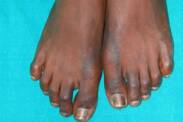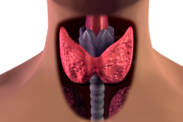Hormonal health of men and women

Cyst in the breast (lump): what are the symptoms? Pain may not be present
A cyst in the breast is a hollow anatomical formation of varying size. It is separated from its surroundings by its own wall. The inside of the cyst may be filled with fluid or connective tissue. It may have several causes.

Cyst on the ovary: Why does it arise, what are its symptoms and diagnosis?
An ovarian cyst is a fluid-filled sac. It is surrounded by a thin layer of tissue. It occurs in the ovary or on its surface.

Obesity and its health consequences. It's not just an aesthetic problem
Obesity has been called an epidemic of humanity. It significantly reduces the quality of life and shortens its duration. It is not a shame, but a serious health and aesthetic problem.

A woman in transition? What are the signs of the approaching menopause?
Terms such as menopause, menopause or transition rightly cause women concern. The manifestations of this period significantly affect life and normal functioning. How to cope with this unpleasant period?

Thyroid cancer - Symptoms, Diagnosis, and Treatments
Thyroid cancer is a malignant tumor. It is one of the most common oncological diseases of the endocrine glands of the human body. However, its occurrence among all malignancies is rather rare. It affects women to a greater extent. Thyroid tumors occur at any age and the success of their treatment depends on early detection.

What is endometriosis, what are its causes and symptoms? + Treatment
Endometriosis refers to a benign, or benign disease that is affected by estrogen. It is one of the most common gynecological diseases. It affects women of reproductive age, especially between the ages of 30 and 40. Endometriosis is basically the occurrence of the endometrium, the inner lining of the uterus, in places outside the uterus.

Addisson disease
Addison's disease, also called Addison's syndrome, is an endocrine disease. It was first described by the British doctor Thomas Addison. According to him, it is also named. Adrenal dysfunction occurs in this disease. They do not produce enough hormones cortisol and aldosterone. So it is adrenal insufficiency and failure. Sometimes the disease is also caused by the fact that the pituitary gland does not produce enough adrenocorticotropic hormone, which in turn stimulates the activity of the adrenal glands.

Hyperparathyroidism and hypoparathyroidism: diseases of the parathyroid glands
Parathyroid hormone is a hormone secreted by the parathyroid glands. It is crucial for regulating the balance of two minerals in the body - calcium and phosphorus. Hyperparathyroidism and hypoparathyroidism refer to conditions where there is a problem in its production.

Hyperthyroidism: Why does it occur and how does it manifest? + Values and treatment
Hyperthyroidism, or the overactive thyroid gland, is relatively common in the human population. It causes a number of unpleasant difficulties. But why?

Hypothyroidism: causes, symptoms and untreated thyroid disease
Hypothyroidism is a condition of reduced thyroid function. In it, the thyroid gland does not produce enough of its hormones, which are thyroxine and triiodothyronine.

Premenstrual syndrome and symptoms? PMS is not just about lower abdominal pain
Premenstrual syndrome is a set of symptoms that affects up to 90% of women of childbearing age. It usually appears about 2 weeks before the actual menstruation. The intensity and variability of symptoms is individual for each woman.

Vaginal Discharge: Causes, Symptoms, Treatment
The discharge from the vagina is whitish in colour even under normal circumstances. In addition, hormonal changes, such as during pregnancy, contribute to whitish discharge. However, if the white discharge is accompanied by other discomforts, it is necessary to think of a disease. Such as an infection.

Cushing's syndrome: What is it and how is it manifested?
Cushing's syndrome is caused by excessive levels of glucocorticoids in the body. This disease is relatively rare. It is the cause of hypertension, weight gain, skin changes, or even a mental disorder. An endocrine disorder can be caused centrally in the brain or peripherally when there is a problem in the adrenal cortex.

Aphthae: Causes, Manifestations, Treatment
Aphthae are among the most common inflammations of the oral mucosa. They affect approximately 20% of the population, both children and adults. Some people develop them only once and others develop them repeatedly throughout their lives. The cause is not yet fully understood.

Vaginal discharge: what does green, yellow, white discharge and itching mean?
Vaginal discharge is individually different as far as each woman is concerned. In some situations, its color, odor, quantity or overall consistency changes. Sometimes the cause is in a hormonal change, sometimes in a disease.










